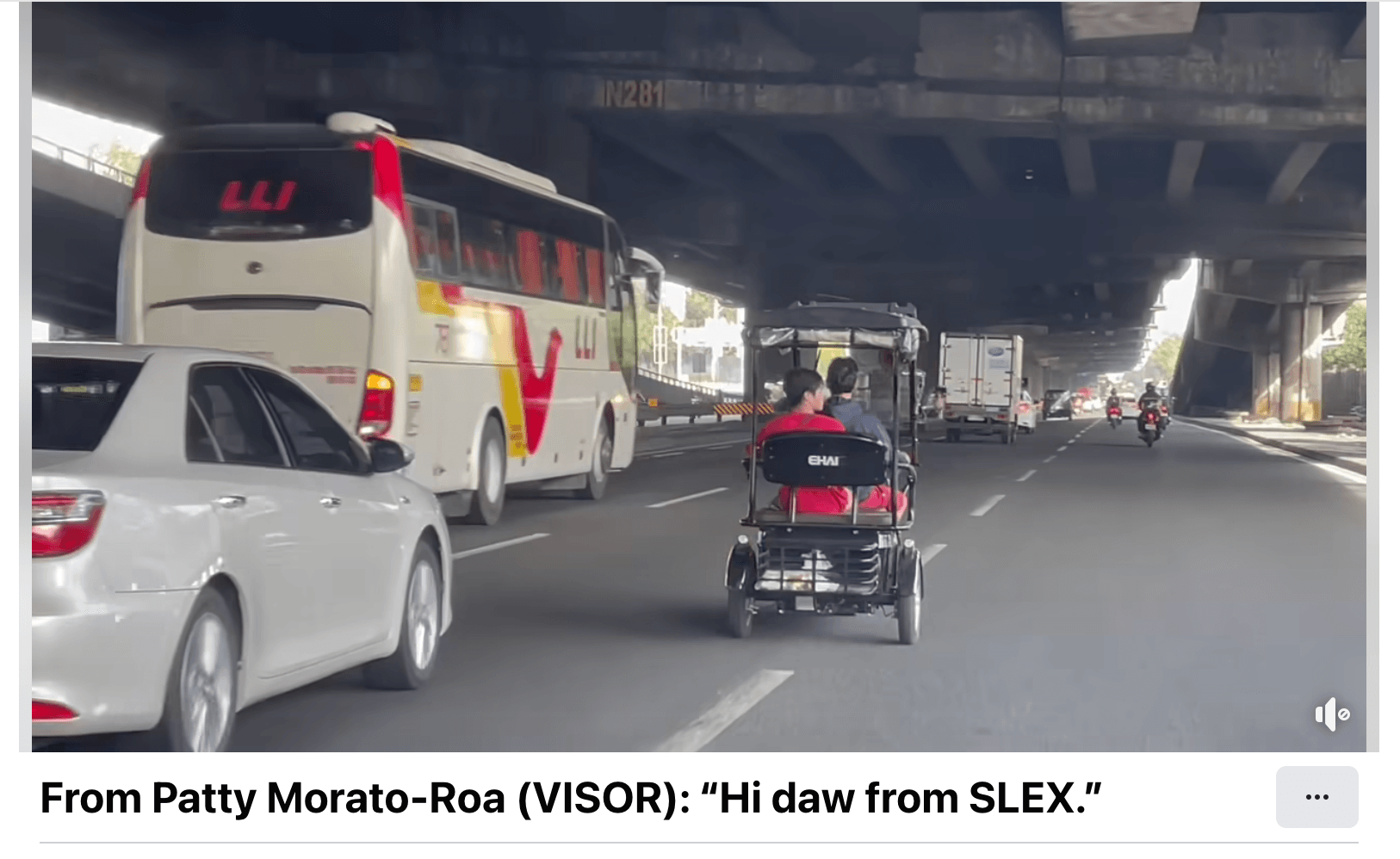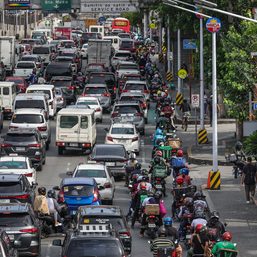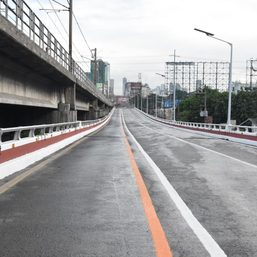SUMMARY
This is AI generated summarization, which may have errors. For context, always refer to the full article.

In a viral video by motoring website Visor, a tiny e-trike drives along the sprawling, high-speed South Luzon Expressway (SLEX).
Teetering on its three wheels and hardly even big enough to seat more than two people, the e-trike seems to crawl along in a world of its own. Cars twice its size whiz by.
Motorists online wondered just how safe it is to let a slow, small electric vehicle onto one of the country’s biggest roads. And it’s not just them; traffic chiefs were worried too.
“Imagine mo, SLEX, ang daming trucks. For quite some time, ‘pag nakita mo ‘yung video, nasa gitna siya ng white line. Hindi siya nasa loob ng isang lane,” said Metropolitan Manila Development Authority (MMDA) Chairperson Romando Artes in a press conference on Thursday, February 15.
(Imagine, it’s SLEX with all those trucks. If you look at the video, for quite some time, the e-trike is in the middle of the white line. It’s not inside a lane.)
In the same press conference, Artes admitted that the rise of e-trikes driving along major roads is a “cause of concern.” So, what regulations does the government have in place to protect them? Not a lot, apparently.

E-trikes and e-bikes remain largely unregulated by the government. The fact that users don’t have to register them or obtain a license to drive them has become a selling point for these smaller electric vehicles. But the drawback of this lax regulation is showing as officials struggle with keeping them off main roads.
“‘Pag hinuli namin tapos walang lisensiya, kanino namin i-issue ‘yung ticket? In the same manner, hindi po registered itong [vehicle]. So, hindi rin namin puwede i-issuehan ng ticket ‘yung e-bike mismo or e-trike,” Artes said.
(If we arrest them and they don’t have a license, who do we issue the ticket to? In the same manner, the vehicle itself isn’t registered. So, we can’t issue a ticket to the e-bike or e-trike directly, either.)
At the same time, without required registration, the government does not have definitive data on how many e-trikes and e-bikes there are currently on the road. But certain local governments attempt to keep records. For instance, in Caloocan City, there are already more or less 18,000 e-trikes, according to Artes during Thursday’s press conference.
But with likely tens of thousands of e-trikes already all over the country, transport officials are scrambling to come up with harmonized guidelines for how to regulate them effectively. Land Transportation Office (LTO) chief Vigor Mendoza II said they are targeting to submit new guidelines to Transportation Secretary Jaime Bautista by next week.
These new guidelines, which Mendoza targets to implement within February, will basically ban e-trikes and e-bikes on major roads.
What are the current regulations?
Currently, there are separate and uncoordinated regulations by the LTO, Department of the Interior and Local Government (DILG), and other local governments that relate to electric vehicles on the road.
One is LTO Administrative Order No. 2021-039. It categorizes electric vehicles into e-scooters, e-mopeds, e-motorcycles, e-trikes, and so on, with varying requirements based on the type of vehicle.
In general, users of electric scooters, e-bikes, and e-mopeds that have a maximum speed of 25 kilometers per hour (kph) and lower are not required to register their vehicle or obtain a driver’s license. They’re also mostly limited to private and barangay roads.
E-bikes and e-mopeds that have a maximum speed of 26 to 50 kph are allowed onto other local roads, but they must take the outermost lane. They may also pass main thoroughfares and national roads but only to cross the road and not to travel along them.
Meanwhile, e-trikes are allowed to go beyond barangay roads and cover local roads and tertiary national roads. Technically, the driver must have a license.
Electric scooters, e-bikes, e-mopeds, e-trikes, and e-motorcycles are prohibited along limited access highways, like SLEX.
A separate issuance, DILG Memorandum Circular No. 2023-195, emphasizes that tricycles are prohibited from national highways, but it doesn’t specifically mention electric vehicles. But while waiting for more comprehensive guidelines to come out, Artes said that enforcement will rely on memos like this one.
“In the meantime, we’ll enforce ‘yung prohibition na ‘yan na hindi sila payagan na bumaybay dito sa mga national roads po natin (the prohibition that does not let them travel along our national roads),” said the MMDA chair. – Rappler.com
Add a comment
How does this make you feel?

![[In This Economy] Why we need to stop the proposed Laguna de Bay expressway](https://www.rappler.com/tachyon/2024/06/Why-we-need-to-stop-Laguna-de-bay-expressway-June-28-2024.jpg?resize=257%2C257&crop=458px%2C0px%2C720px%2C720px)


![[EDITORIAL] Kamaynilaan para sa tao, hindi para sa mga sasakyan](https://www.rappler.com/tachyon/2024/04/animated-traffic-april-2024-carousel.jpg?resize=257%2C257&crop=410px%2C0px%2C720px%2C720px)
There are no comments yet. Add your comment to start the conversation.